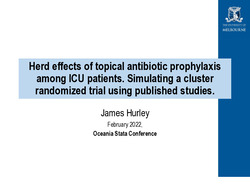Please use this identifier to cite or link to this item:
http://hdl.handle.net/11054/1957Full metadata record
| DC Field | Value | Language |
|---|---|---|
| dc.contributor | Hurley, James C. | en_US |
| dc.date.accessioned | 2022-08-05T06:26:22Z | - |
| dc.date.available | 2022-08-05T06:26:22Z | - |
| dc.date.issued | 2022 | - |
| dc.identifier.govdoc | 01911 | en_US |
| dc.identifier.uri | http://hdl.handle.net/11054/1957 | - |
| dc.description.abstract | Abstract: Importance: Topical antibiotic prophylaxis (TAP) appears to have potent direct effects towards preventing ventilator associated pneumonia (VAP) and other infections acquired by intensive care unit (ICU) patients within randomized concurrent controlled trials (RCCT). Whether TAP engenders indirect (herd) effects on concurrent ICU patients is of great interest. Objective: To estimate the indirect effects of TAP among concurrent control group patients using data from six broad categories of VAP prevention arranged to simulate a cluster randomized trial (CRT). Design, setting and participants: Control and intervention groups from 210 published RCCTs from 14 Cochrane reviews of VAP prevention interventions among ICU patients excluding RCCTs with fewer than 50% of patients receiving mechanical ventilation (MV). Exposures: Indirect exposure of control groups within TAP RCCTs versus within RCCTs of other VAP prevention interventions in five broad categories. Main outcomes and measures: The proportion of patients with VAP or ICU mortality (primary outcomes), aggregated separately for control and for intervention groups, as abstracted towards deriving study level intervention effect size estimates within each Cochrane review. Results: Among 14 Cochrane reviews, the strongest summary effect sizes were apparent for VAP and mortality prevention among TAP RCCTs. Surprisingly, the ICU mortality among TAP intervention groups (23.3 [95% CI, 19.5–27.5]) versus an intervention group benchmark derived from the five other categories of intervention (21.1 [95% CI, 19.0–23.3]), respectively, were similar. By contrast, the ICU mortality among TAP control groups was higher versus a control group benchmark derived from the five broad categories of intervention, being 27.9 (95% CI, 23.5–32.5) versus 21.3 (95% CI, 19.2–23.2), respectively. This higher control group mortality remained evident in sensitivity analyses incorporating groups with late mortality, adjusting for group mean age and year of study publication. Conclusions and Relevance: The control group event rates that underlie the strong summary intervention effect sizes within TAP RCCT’s among patients requiring MV are unusually high. This implicates strong indirect effects from TAP prophylaxis among MV patients and raises concern that the indirect effects to concurrent control group patients, whilst harmful, underlie the appearance of overall benefit. | en_US |
| dc.description.provenance | Submitted by Gemma Siemensma (gemmas@bhs.org.au) on 2022-08-04T00:55:16Z No. of bitstreams: 0 | en |
| dc.description.provenance | Approved for entry into archive by Gemma Siemensma (gemmas@bhs.org.au) on 2022-08-05T06:26:21Z (GMT) No. of bitstreams: 1 Herd effects of topical antibiotic prophylaxis.pdf: 3518476 bytes, checksum: 69b65cfbfca9af572fc8b1188ca7227a (MD5) | en |
| dc.description.provenance | Made available in DSpace on 2022-08-05T06:26:22Z (GMT). No. of bitstreams: 1 Herd effects of topical antibiotic prophylaxis.pdf: 3518476 bytes, checksum: 69b65cfbfca9af572fc8b1188ca7227a (MD5) Previous issue date: 2022 | en |
| dc.title | Herd effects of topical antibiotic prophylaxis among ICU patients: Simulating a cluster randomized trial using published studies. | en_US |
| dc.type | Conference | en_US |
| dc.type.specified | Presentation | en_US |
| dc.bibliographicCitation.conferencedate | February 10 | en_US |
| dc.bibliographicCitation.conferencename | Oceania Stata Conference | en_US |
| dc.bibliographicCitation.conferenceplace | Online | en_US |
| dc.subject.healththesaurus | ANTIBIOTIC PROPHYLAXIS | en_US |
| dc.subject.healththesaurus | INTENSIVE CARE | en_US |
| Appears in Collections: | Research Output | |
Files in This Item:
| File | Description | Size | Format | |
|---|---|---|---|---|
| Herd effects of topical antibiotic prophylaxis.pdf | 3.44 MB | Adobe PDF |  View/Open |
Items in DSpace are protected by copyright, with all rights reserved, unless otherwise indicated.
